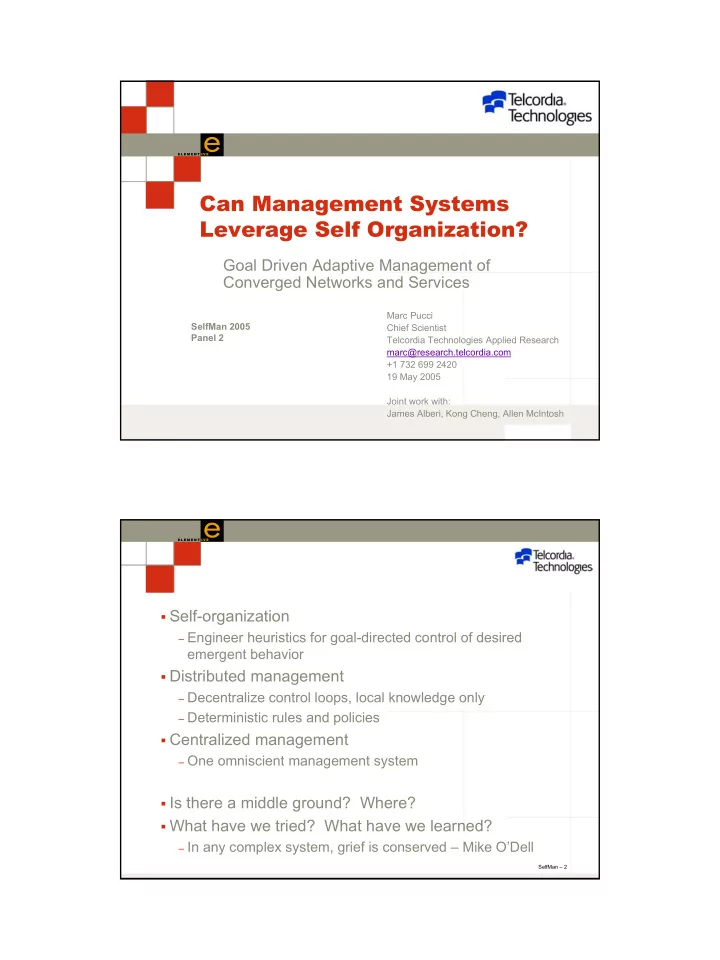

Can Management Systems Leverage Self Organization? Goal Driven Adaptive Management of Converged Networks and Services Marc Pucci SelfMan 2005 Chief Scientist Panel 2 Telcordia Technologies Applied Research marc@research.telcordia.com +1 732 699 2420 19 May 2005 Joint work with: James Alberi, Kong Cheng, Allen McIntosh � Self-organization – Engineer heuristics for goal-directed control of desired emergent behavior � Distributed management – Decentralize control loops, local knowledge only – Deterministic rules and policies � Centralized management – One omniscient management system � Is there a middle ground? Where? � What have we tried? What have we learned? – In any complex system, grief is conserved – Mike O’Dell SelfMan – 2 1
Challenges � Complex systems require multiple types of controllers – Avoid destructive interference between controllers – How do we make sure multiple controllers work towards the greater good? � Local controllers optimize without global objectives – E.g., Bandwidth load balancing in the face of DDoS attack – Tend to be local resource aware, not service aware – But can be self-organizing � Difficult to increase awareness in local controllers – Usually impossible to modify proprietary systems – Too complex, will never keep up with growth of constraints – Wrong Approach? Still need a coarse-grain behavior modifier? – But is some amount of local interaction needed? � Too many rules – Better knowledge representation – Adaptive weight setting, learning SelfMan – 3 Where do we apply controls? Billing Network OSSs Softswitch Application/Media • Configuration SCP Application (Signaling GW LNP Servers AMADNS • Fault MGC Call Name (e.g. Auto Attendant • Performance Traffic CORBA Feature Server 800 DB Meet-Me Conf Network Line Side Control AIN SCP Feature Svr Unified Messaging Wiretap Trunk Side) SNMP DBs Settings Server (e.g IP Centrex) CallCenters) HTTP CCS Network Call Admission Legacy PBX IP Phone Control Softswitch CAS/PRI PBX Codec Settings CAS or PRI Settings Intra or Inter PBX GW DNS/DHCP/ Carrier Softswitches Radius Svrs Internal Policing, Reduction of MPLS Route Marking, IP PBX Changes Shaping Permitted Burst PSTN T D M Transport U P Capacity ( P R I , I S F ) Network o r M MPLS + Managed IP PSTN Diffserv Peer-to-Peer Network Gateway TCAP Session IAD Ratio Settings Access Access Network Border Routing Control Controller Bandwidth Legacy Consumer or SME Settings Voice Mail Enterprise SelfMan – 4 2
Local Resource Controller example - Automatic Bandwidth Management SelfMan – 5 MPLS Bandwidth Management � Closed Loop – Monitor – Analyze - Reconfigure – Single Goal – Simple Objective function Minimize maximum load � Minimize hop count over minimum possible hops � � Use of Trending and Prediction � Could be self organizing, adapting to load usage patterns � But - Not Service Aware – all bandwidth users are equal Performance Measurement Network Probes System Load VPN Loads Generators DATA New LSPs Current Data MPLS Network Network Configuration, LSP Configuration, Performance Data Analysis LSP Control Engine Configuration SelfMan – 6 3
� What happens when multiple applications have conflicting demands on the same supporting set of resources? – Converged networks with voice, video, data – Differing demands on delay, jitter, bandwidth � No single, static solution will suffice – Allow local controllers to operate in well-defined comfort zones – Be careful about allowing local controllers to conspire � E.g., VoIP manager dealing with MPLS bandwidth manager – Invoke (passively or actively) higher level management when zones are violated – Don’t micro-manage � Additional considerations to manage: – Changing priority of services and sessions within services – Profitability of services � Admit billable voice call rather than in-plan call � Limit data capacity to allow high speed, high QoS video transmission � Discard existing traffic to allow new applications to fit SelfMan – 7 Experimental Telcordia Test Bed for Multi- Layer Converged Services Management Independent Controllers manage private view of their world � Free Running Controllers � VoIP Until exception occurs – Service Rule driven interactions Manager � Global Policy Manager (Arpeggio) IP/MPLS Bandwidth Manager (PECAN) Optical Manager ROADM ROADM Optical BoD Service UCSD BoD Ring Manager Service Client ROADM ROADM SelfMan – 8 4
Recommend
More recommend